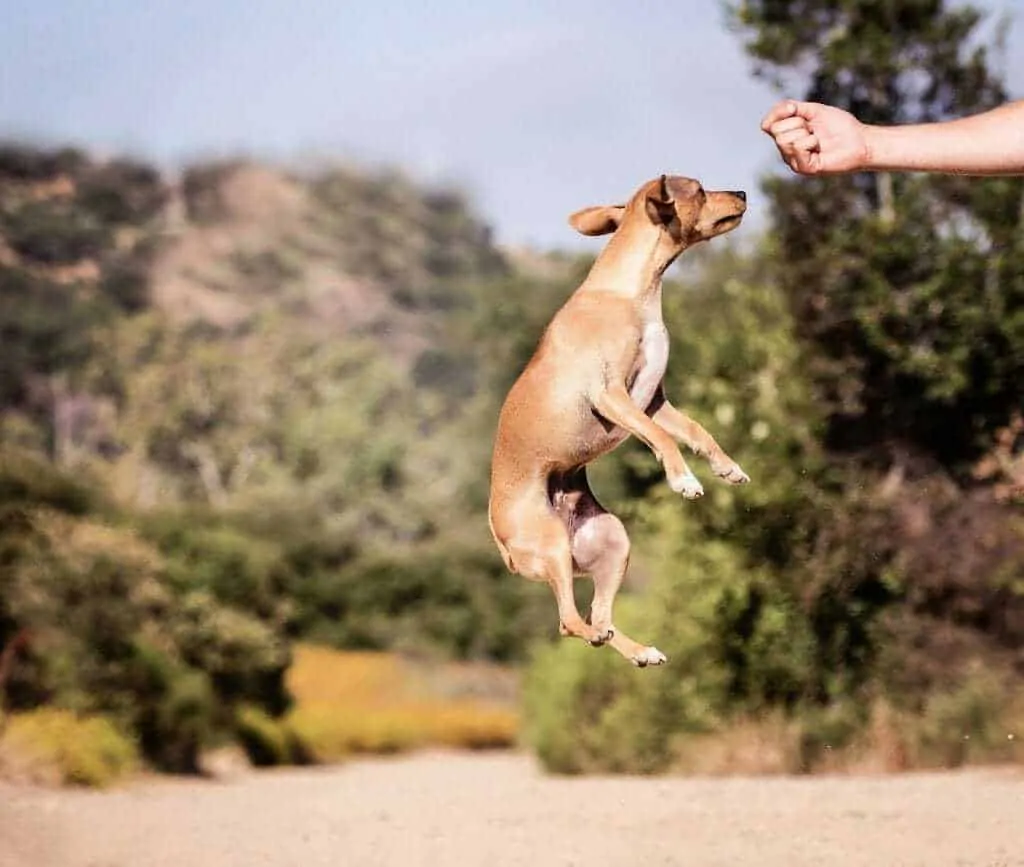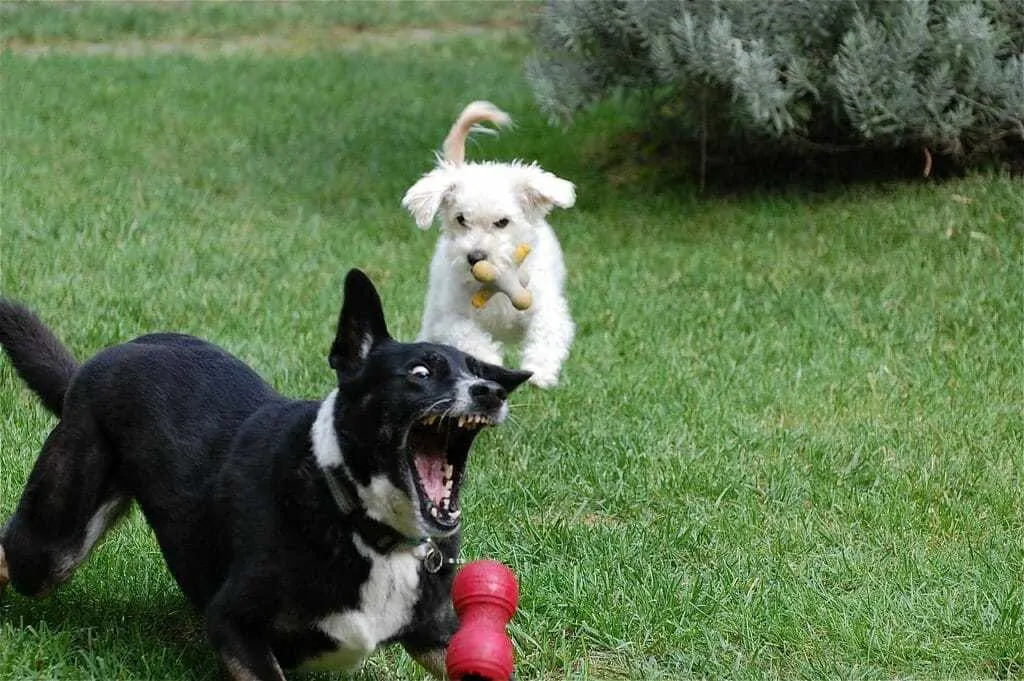Many pet owners strive to provide mental stimulation for their dog, but they don’t understand why mental exercises are so important. We all love our dogs, and we know that they love chews and toys, but mental stimulation is so much more than tossing a few bones their direction. The best way for you to understand why your dog needs mental stimulation is by looking back at the behavior of their ancestors.
Contents
Why Mental Stimulation? Going Back to Your Dog’s Ancestry
When you watch television, advertisers inundate you with dog food commercials talking about “the wolf in your dog” and “true predators.” In fact, many people think we bred dogs directly from wolves. However, our dog’s ancestry is much more complicated than that.
This video is a great example of how media misleads dog owners into thinking that dogs and wolves are one and the same. In reality, their biological and psychological needs are quite different.
Modern research tells us that wolves and dogs had a common ancestor, but that they evolved separately from one another. Surprisingly, that division happened over 20,000 years ago! Basically, half the ancestors evolved into our modern wolves, and the other half became our dogs. But the biggest difference is how they survived.
The Apex Predator
You know how a wolf pack hunts. The best way to take down a large prey item, like a deer or an elk, is working together. This involves lots of teamwork and cooperation, and lots of energy.
A pack of wolves feeding after a successful hunt.
Like any apex predator, not all hunts succeed so wolves have to conserve energy when they aren’t hunting. This means that they use a burst of energy, catch food, eat food, and sleep the rest of the time. Sounds like a good way for a dog to behave, but like we discussed above, dogs aren’t wolves!
The Scavenging Predator
Our dog’s ancestors didn’t catch the same prey as wolves. Instead they found a new food source near humans, garbage and the vermin that feed on it. Garbage and rats don’t exactly make for huge meals, so the best way for your dog’s ancestors to conserve energy was to constantly search for food. Unfortunately for us, this means that our dogs are hard wired mentally to feel like if they don’t forage they will starve! Scavenging behavior, like getting into the garbage, can even be dangerous for our dogs if they scarf down something toxic like Xylitol.
Key Scavenging Predator Behaviors
Because your dog’s ancestors were scavenging predators, they feel the evolutionary need to do the same behaviors their ancestors did to survive. We call this the predatory sequence, and it involves many of these behaviors.
- Sniff and search for food
- Track scent
- Stalk food
- Manipulate objects to reach food
- Chase or leap at food
- Grab food
- Shake or tear apart
- Chew
- Eat
Nowadays our dogs don’t need to catch their own food (you know, since we neatly put their whole meal in a bowl for them). However, that doesn’t mean those instincts just go away. Essentially, for your dog to be happy, the best mental exercises need to involve some of those predatory behaviors.
A dog playing fetch exhibits natural chasing, leaping, and grabbing behaviors. Some breeds, like golden retrievers, thrive best while doing specific behaviors like fetch.
Behaviors of a Bored Dog
So why should you bother providing mental exercises for your dog? Of course you want your dog to be happy, but you play with them and take them on walks so what exactly does adding more mental stimulation do for them? Well, when your dog isn’t getting enough mental exercise, especially if they are younger or more energetic, they start doing more undesirable behaviors.
Even though not all these behaviors come directly from a “bored” dog, lack of mental stimulation is usually one of the first steps towards problem behaviors. This happens in all animals, not just dogs. All the best zoos add mental exercises in the form of enrichment to prevent problem behaviors like overeating and pacing. Some of the things our dogs do when they get bored include:
- Chewing/destruction
- Barking
- Jumping
- Hyperactivity
- Leash pulling
- And more
Not all dogs are so gentle with their owner’s shoes. Chewing is just one of several disruptive behaviors that dogs perform when they do not get enough mental exercise.
The Two Types of Mental Exercises
From our list above, you know that there are many different types of behaviors your dog wants to perform during mental exercises. However, there are two primary methods for you to provide mental stimulation for your dog: hands-on exercises and hands-off exercises. For hands-on exercises, you are directly working or playing with your dog. Alternately, for hands-off exercises you can give your dog the activity and he/she works on it on their own.
Best Hands-On Mental Exercises for Your Dog
When you have the free time, hands-on exercises are one of the best ways for you to make sure your dog is getting enough mental exercise. Not only does your dog get to use their brain, but you get to bond with your dog as well! Below we have listed several different activities that are great for upping your dog’s mental stimulation.
1. Training
Nothing beats a good ol’ brainteaser! Teaching your dog something new, or brushing up on old behaviors that they might have forgotten, is the best way to get their brain working. When you teach your dog a behavior they have to use problem solving skills to understand what exactly you want from them, burning some great mental energy. Even a simple exercise like target training is a great way to start training your dog.
Pro Tip: Teach your dog using verbal commands as well as hand signals. Making the connection between a new word and the hand signal that they’ve already learned is just another mental obstacle for them to overcome!
It doesn’t matter what you teach your dog. Learning how to do new behaviors, even just jumping in the air, is great mental exercise.
2. Shaping
Shaping is basic training on steroids. While most training techniques use luring to teach your dog a new behavior, shaping makes your dog connect the dots him/herself! In essence, you are playing a game of hot or cold with your dog, and using treats to let them know when they are getting warmer. Many pet owners think clickers are best during this process because they are simple and precise. By making your dog figure out the steps on their own, you just add more mental exercise to the already mentally stimulating activity of learning new behaviors.
This video is a good example of how to start using shaping with your dog to increase their mental exercise.
3. Tug/Fetch
You already know your dog wants to chase, grab, shake, and repeat, so let’s make a game out of it! Some people believe that tug causes aggression, but research shows that this isn’t true when done correctly. For best results, teach your dog a “drop” command. Now, they can perform all these behaviors that they crave, and you can test their self-control while doing so.
Pro Tip: During the game, periodically ask your dog for a behavior that they know, like “sit,” “down,” or “roll over.” This keeps them guessing and makes the game even more mentally stimulating for them!
Some dogs get really excited for a good game of fetch!
4. Hide & Seek
Brush up on your “stay” command because we’re going to play a game of hide and seek! It’s a really simple game that your dog will love, and it’s no different than your standard game of hide and seek, except with a few treats added. Simply hide from your dog, and reinforce them with some yummy treats when they find you. This exercise lets your dog perform some of those essential searching and tracking behaviors discussed earlier in the article.
Pro Tip: If your dog has some difficulty at first, make sure you hide in simple places that are easy to find. When they hit a stalling point, you can simply make a little noise to push them in the right direction and let them succeed.
Hide and seek is a great game for kids to play with dogs too! Even if your dog finds them quickly, it just adds to the excitement.
Best Hands-Off Mental Exercises for Your Dog
When it comes down to it, you just don’t have all day to interact with your dog. So when you’re at work, cooking, or just too busy, these are the best hands-off mental exercises to keep your dog occupied.
5. Treat Balls
There are lots of different treat balls on the market, some great, and some not-so-great. The concept is simple, you put treats in and your dog works to make the treats fall out. Not all of the best “treat balls” are actually ball-shaped, but that’s just fine!
IQ Treat Ball
No products found.
This hard plastic treat ball is easy to open and refill. You can simply unscrew the top, drop in a handful of treats, and let your dog go to work. This is one of our favorite exercises for its simplicity and ease of use.
Starmark Treat Dispensing Chew Ball
No products found.
Made with soft, flexible rubber, this ball might not be for you if your dog is a tough chewer. However, if your dog isn’t too tough on his/her toys, you’ll love this treat ball. Dogs love to roll and bite this treat ball to remove the treats.
KONG Genius “MIKE”
No products found.
If your dog is a little too smart for their own good, this treat “ball” might be for you! This toy is more difficult to get treats out of because you have to flip it up instead of just rolling it.
Foobler
No products found.
For those of you that need to leave all day for work, the Foobler is the perfect addition to your toy chest. You can fill foobler with treats, and it will release each chamber on a timer so your dog gets all-day mental exercise!
6. Chews
You don’t have to be a rocket scientist to realize that most dogs love chewing on things! If you provide your dog with enough novel chewing opportunities, you just might save your favorite pair of shoes from destruction. Here are a few of our favorite chews for dogs.
Bully Sticks
No products found.
Bully sticks, also known as bull pizzle, are a fan favorite amongst most dogs. They can chew up and eat the entire stick safely. These chews are great for heavy chewers, and you can get a variety of different shapes. For smaller dogs or light chewers, a basic six-inch bully stick is usually the best choice. If your dog is a little tougher, choose a braided, spiral, or an extra long!
Pro Tip: Bully sticks are fully digestible, but they are high in fat. Feed sparingly as a treat.
Deer Antlers
No products found.
Unlike bully sticks, your dog cannot chew and eat an entire deer antler. However, that doesn’t mean that they won’t love chewing on it! For best results, pick a split deer antler so your dog can gnaw at the marrow inside.
Pro Tip: It is best to watch your dog carefully the first few times you give them a deer antler. Sometimes heavy chewers can break off pieces of the antler that are dangerous to ingest.
Himalayan Chews
No products found.
This might be one of the strangest additions on our list. Himalayan chews are made of yak’s milk, and look a bit like a chunk of smoked fish. While not all dogs are fans, many like to chow down on this chew for an hour or more! When they have chewed it down to a small chunk, you can toss it in the microwave and create a cheese puff for them!
See additional dog chew reviews here.
7. Other Work-to-Eats
Chews and treat balls aren’t the only way to keep your dog entertained. Here are a few other types of work-to-eats that don’t quite fit into the above categories.
KONG Dog Toy
No products found.
As a pet owner, you have probably seen the classic red KONG at some point. The very best way to use a KONG is if you fill it with something mushy. Our favorite is a mixture of plain canned pumpkin and peanut butter. If you’d like, you can add pieces of dog food, or pet-safe fruits and veggies. To make it last even longer, freeze it before you give it to your pup!
Pro Tip: Even if your dog isn’t a heavy chewer, buy the KONG Extreme Dog Toy rather than the classic. The Extreme lasts virtually forever, and you can run it through your dishwasher when it gets messy.
Everlasting Treat Wheeler
No products found.
This one is a little like a chew, but with some added difficulty. Your dog has to maneuver the toy around to find the best spot to work on the treat inside. Make sure you remember to get a few refills for when you run out.
Ice Pops
There’s nothing more refreshing than a popsicle on a hot summer day. You can easily use a small tupperware container to make a popsicle for your dog. Add a variety of fruits and vegetables, or even your dogs favorite plastic toy.
Pro Tip: It’s best to give this one outdoors where you can easily wash away any mess. Popsicles melt really quickly!
This video gives a great alternative to ice pops with some yummy ice cream, but requires a little more time and effort.
See more great puzzle toys here.
8. Tech-Savvy Innovations
New innovations are constantly on the rise, and the same goes for our pet care as well. Here are a few great ways to make sure your dog gets plenty of mental exercise, even when you’re away.
Tennis Ball Launcher
No products found.
If your dog is a fast learner, you can teach them to use a tennis ball thrower when they want to play fetch. It might take a little time for them to learn, but avid fetchers can play whenever they want, even when you aren’t home!
Treat Dispensing Pet Cameras
No products found.
We all know about nanny cams, and now we have an upgraded version for our dogs. You can sneak a peek at your pet while you’re away, and all you have to do is grab your phone! The best versions even let you toss treats to your dog with the push of a button!






